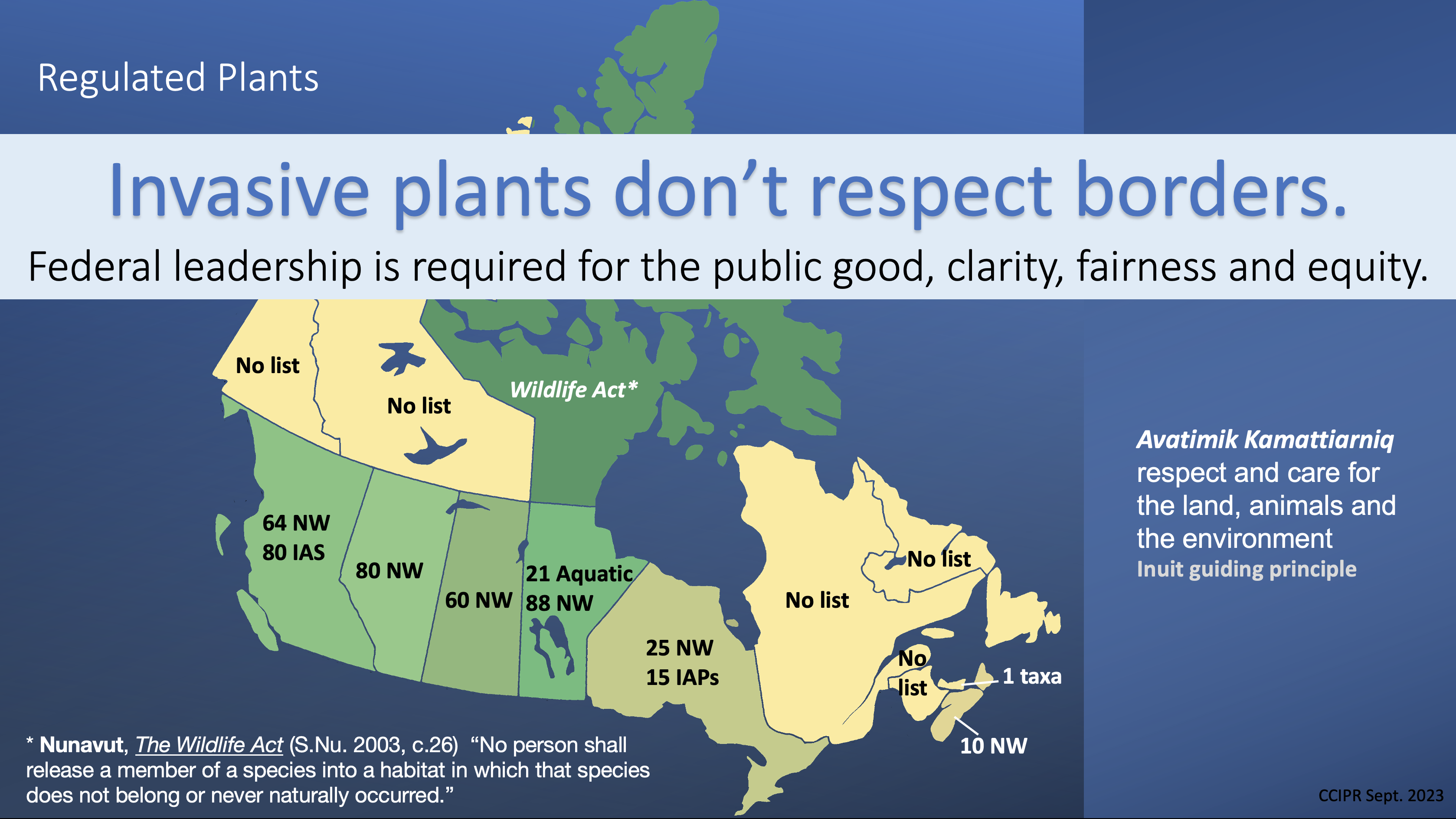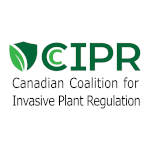
Plants regulated by the federal government are largely those that impact agriculture and are regulated as contaminants of seed. Very few invasive ornamental plants are regulated despite the many threats they pose to our economy, environment, and human health.
Regulations vary greatly by jurisdiction, with several provinces and territories having no regulations. Overall, there are 238 plants regulated by Canada and the provinces. The US border states regulate over 500 plants and include many more ornamental plants.
We compiled a list of high-risk plants currently regulated in parts of Canada and in the 13 US Border States. We have added lists of high-risk aquatic plants identified by the Department of Fisheries and Oceans and compared these lists to the plants that currently appear in the Canadian Food Inspection Agency (CFIA) Weed Risk Assessment documents. Based on these lists, we have identified over 90 high-priority plants that should be assessed or reassessed by the CFIA. Here is the file containing those spreadsheets (download here). (As we have likely made errors in the arduous compilation process, you can confirm data using the primary sources found on our Province and territory regulations page and State regulations page.
Additionally there are many invasive ornamental plants that are not currently regulated. Some of those appear on the lists developed by plant councils below. Some of the ornamental terrestrial and aquatic invasive plants currently identified by invasive plants councils across Canada and or included in the Invasive Alien Plants in Canada – Technical Report are listed below.
This is a partial list of known threats across Canada as identified by Canadian authorities and plants that are regulated by multiple states bordering Canada (indicated by bold type face):
velvetleaf (Abuliton theophrasti)
maples: Amur, Norway, & sycamore (Acer ginnala, A. platanoides, & A. pseudoplatanus)
sweet flag, European (Acorus calamus)
goutweed (Aegopodium podagraria)
tree of Heaven (Ailanthus altissima)
garlic mustard (Ailliaria petiolata)
gugleweed (Ajuga reptans)
lady’s mantle (Alchemilla mollis)
alder, European black (Alnus glutinosa)
porcelainberry (Ampelopsis glandulosa)
angelica, woodland (Angelica sylvestris)
chervil, wild (including ‘Raven’s wing’) (Anthriscus sylvestris)
mosquitofern, pinnate or feathered (Azolla pinnata)
barberry: Japanese & common (Berberis thunbergii, B. vulgaris)
butterfly bush (Buddleja davidii)
flowering rush (Butomus umbellatus)
fanwort, Carolina (Cabomba caroliniana)
bellflower, creeping (Campanula rapunculoides)
peashrub, Siberian (Caragana arborescens)
bittersweet, oriental (Celastrus orbiculatus)
knapweeds: bachelor’s buttons, big, & mountain bluet (Centaurea cyanus, C. macrocephala, C. montana)
clematis, yellow (Clematis tengutica)
lily of the valley (Convallaria majalis)
swamp crop, Australian (Crassula helmsii)
hound’s tongue (Cynoglossum officinale)
flatsedge (Cyperus difformis)
broom (Cystitis scoparius)
spurge-laurel (Daphne laureola)
foxglove (Digitalis purpurea)
viper’s-bugloss (Echium vulgare)
elodea, Brazilian (Egeria densa)
hyacinth, water (Eichhornia crassipes)
olive, Russian and autumn (Elaeagnus angustifolia & E. umbellata
euonymus, winged & winter creeper (Euonymus alatus, E. fortunei)
spurges – leafy, myrtle, and cypress (Euphorbia esula, E. myrsinites, E. cyparissias)
buckthorn, glossy (Frangula alnus)
mannagrass, floating & great Glyceria fluitans & G. maxima
baby’s breath (Gypsophila paniculata)
ivy, English (Hedera helix)
daylily, common (Hemerocallis fulva)
hogweed, giant (Heracleum mantegazzianum)
dame’s rocket (Hesperis matronalis)
hawkweeds, introduced (Hieracium spp.)
sea buckthorn (Hippophae rhamnoides)
St. John’s wort, common (Hypericum perforatum)
hydrilla (Hydrilla verticillata)
frog-bit, European, & American (Hydrocharis morsus-ranae, & H. spongia)
water poppy (Hydrocleys nymphoides)
hygrophila, east Indian (Hygrophila polysperma)
St. John’s wort (Hypericum perforatum)
holly, English (Ilex aquifolium)
balsam, Himalayan; & small flower (Impatiens glandulifera, I. parviflora)
cogongrass (Imperata brasiliensis & I. cylindrica)
iris, yellow flag (Iris pseudacorus)
dyers’ woad (Isatis tinctoria)
oxygenweed, African (Lagarosiphon major)
lamium, yellow archangel & purple (Lamium galeobdolon, L. purpureum)
daisy, oxeye (Leucanthemum vulgare)
privet, border (Ligustrum obtusifolium)
toadflax (Linaria dalmatica, L. vulgaris, L. genistifolia subsp. dalmatica)
honeysuckles: Japanese, Amur, Morrow’s, Tatarian, & Bell’s, fly (Lonicera japonica, tatarica, L. maackii, L. morrowii, L x bella, L. xylosteum)
creeping Jenny (Lysimachia nummularia)
loosestrife (Lythrum salicaria, L. virgatum)
water-clover, European (Marsilea quadrifolia)
clover, white sweet (Melilotus alba)
grass: miscanthus (Miscanthus sinensis, M. sacchariflorus)
mulberry, white (Morus albą)
watermilfoil: parrot feather, twoleaf, & Eurasian (Myriophyllum aquaticum, M. spicatum, M. heterophyllum*)
star of Bethlehem (Ornithogalum nutans)
waternymph, brittle (Najas minor)
nasturtium, yellowcress (Nasturtium officinale)
stonewort, starry (algea) (Nitellopsis obtusa)
waterlily, European (Nymphaea alba)
floating heart, yellow (Nymphoides peltata)
duck lettuce (Ottelia alismoides)
knotweed, Himalayan (Persicaria wallichii)
grass, torpedograss (Panicum repens)
smartweed, marsh-pepper (Persicaria hydropiper)
grass, canary reed (Phalaris arundinacea)
cork tree, Amur (Phellodendron amurense)
phragmites (nonnative); reed, common (Phragmites australis var australis)
hawkweed, orange (Pilosella aurantiaca)
pine, Scotch (Pinus sylvestris)
water lettuce (Pistia stratiotes)
poplar, silver (Populus alba)
cinquefoil, sulfur (Potentilla recta)
pear, Callery (Pyrus calleryana)
pondweed, curly-leaf (Potamogeton crispus)
cherry, European bird (Prunus padus)
knotweeds: Japanese, giant, Bohemian (Reynoutria japonica syn Fallopia japonica, R. sachalinensis, R. × bohemica)
pilewort; celandine, lesser (Ranunculus ficaria)
buckthorn, common (Rhamnus cathartica)
locust, black (Robinia pseudoacacia)
rose, multiflora & rugose (Rosa multiflora & R. rugosa)
blackberry, wild complex (Rubus fruticosus)
arrowhead, giant (Sagittaria sagittifolia)
salvinia, giant & common (Salvinia auriculata, S. biloba, S. minima, S. molesta, & S. natans)
bulrush, ricefield (Schoenoplectiella mucronata)
stonecrop, goldmoss (Sedum acre)
spirea, false (Sorbaria sorbifolia)
mountain ash, European (Sorbus aucuparia)
water soldier (Stratiotes aloides)
comfrey (Symphytum officinale)
tamarisk; saltcedar (Tamarix spp. T. ramosissima, T. chiniensis, T. parviflora or any cultivars, variety, or hybrids)
tansy (Tanacetum vulgare)
waterchestnut, European (Trapa natans)
cattail, narrow leaf, & white (Typha angustifolia, T. x glauca)
valerian, common (Valeriana officinalis)
grass, eel (Vallisneria spiralis)
cranberry, European high-bush (Viburnum opulus)
periwinkle (Vinca major, & V. minor)
swallow-wort, black & Louise’s; dog-strangling vine (Vincetoxicum nigrum; syn. Cynanchum louiseae & V. rossicum)
Wildflower Mixes that contain invasive species
*native and introduced variants
Plant lists and councils:
Canada
- Canadian Council on Invasive Species https://canadainvasives.ca
- Invasive Species Centre (ISC) Plant Lists
- Canadian Council on Invasive Species CANADA’S UNWANTED INVASIVE PLANTS
Alberta:
- Alberta Invasive Council Grow Me Instead
- Invasive Plants of Alberta 4th Edition 2022
- Alberta Invasive Plant Identification GUIDE: Prohibited Noxious and Noxious Weeds
Atlantic Canada:
- New Brunswick Council of Invasive Species www.nbala.ca/new-brunswick-council-of-invasive-species
- Nova Scotia/New Brunswick Plant Wise
- Nova Scotia Invasive Species Council Invasive Species List
- Newfoundland and Labrador – Exotic and Invasive Alien Speices in Newfoundland and Labrador (pdf)
- PEI Invasive Species Council Invasive Plant Lists
British Columbia:
- BC Invasive Terrestrial Plant List
- BC Invasive Species Council Grow Me Instead
- Official BC Ministry of Forests invasive species list
- InvasivesBC database, map and mobile data collection application
Manitoba:
- Manitoba Master Gardeners Invasive Plants
- Manitoba Invasive Species Council Grow Me Instead (pdf)
Ontario:
- Ontario Weed Control Act, (R.S.O. 1990, c. W.5) controls plants that are negatively impacting agriculture and horticulture lands. Currently there are 25 species designated noxious weeds in Ontario. This is a complaint driven act. Ontario Noxious Weeds posted by the Ministry of Agriculture food and Rural Affairs contained only common names and no scientific names (as of June 2023)
- Ontario Invasive Species Act https://www.ontario.ca/laws/regulation/160354 Scroll to bottom from prohibited and restricted plant lists. Note that no person shall propagate, buy, sell, trade or offer to buy, sell, lease or trade a prohibited and restricted invasive plants.
- Ontario Invasive Aquatic Plant List https://www.ontario.ca/page/invasive-aquatic-plants
- Auditor General of Ontario – Value for Money Audit (2022)
- MidAtlantic Invasive Plant List – https://www.mipn.org/plantlist/ (2024 in progress)
- Credit Valley Conservation Invasive Plant List (2021)
- Ontario Invasive Plant Council Grow Me Instead; Ontario Invasive Species Awareness
- Ontario Federation of Anglers and Hunters in partnership with Ontario Ministry of Natural Resources, Credit Valley Conservation – Appendix to A Landowner’s Guide to Managing and Controlling Invasive Plants in Ontario (2014)
- Upper Thames Conservation Invasive Non-native plants
- Ontario South Central Conservation Authorities Invasive plants (collated from member websites 2023)
Northwest Territories:
- Northwest Territories – Invasive and Alien Species Information Page; A Risk Assessment of Invasive Alien Species in the NWT
- NWT Stop the Spread
Nunavut:
- Nunavut – Non-native invasive species in Nunavut (Poster)
Saskatchewan:
- Saskatchewan Invasive Species Council Invasive Plant Fact Sheets
Yukon:
- Yukon Invasive Species Council Grow Me Instead (pdf)
North America:
- AKEPIC (Alaska Exotic Plant Information Center)
- Invasive Plant Atlas (US and Canada) Plant Species Reported to be Invasive in Natural Areas (1405 Records, 2018)
- Plant Invaders of Mid-Atlantic Natural Areas (Swearingen, J., B. Slattery, K. Reshetiloff, and S. Zwicker. 2010. Plant Invaders of Mid-Atlantic Natural Areas, 4th ed. National Park Service and U.S. Fish and Wildlife Service. Washington, DC. 168pp.)
- U.S. Invasive Plant Atlas
- Public Gardens as Sentinels of Invasive Plants Dashboard
- Regional Invasive Species & Climate Change (RISCC) Management Networks
International:
- CABI Invasive Species Compendium https://bplant.org/website/14
- InvaCost https://www.invasivespeciescentre.ca/invacost-the-cost-of-invasive-species/
- Global Invasive Species Database 100 world’s worst species
- EU Invasive alien species of Union concern
